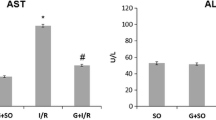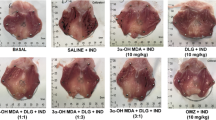Abstract
The purpose of this study was to examine whether tetrahydrobiopterin (BH4), a cofactor of nitric oxide (NO) synthase, attenuates gastric ischemia–reperfusion injury induced by clamping of the celiac artery. Gastric injury was assessed by a formation of gastric mucosal erosions. The gastric injury was observed at 30 and 60 min after reperfusion following 30-min ischemia and was reduced by superoxide dismutase (SOD), catalase, or NO synthase inhibitors. Therefore, reactive oxygen species (ROS) and NO seem to be implicated in the ischemia–reperfusion injury. Treatment with BH4 reduced the ischemia–reperfusion injury. Pretreatment with sepiapterin, a precursor of BH4, also reduced the ischemia–reperfusion injury with an increase in BH4 content in serum and stomach. Both the increase in BH4 content and the protective effect of sepiapterin were prevented of pretreatment with N-acetylserotonin, an inhibitor of BH4 synthesis. These results suggest that the increase in BH4 content may protect against gastric ischemia–reperfusion injury via reduction of ROS and/or NO toxicity. BH4 might be useful as a therapeutic agent for gastric ischemia–reperfusion injury.
Similar content being viewed by others
REFERENCES
Rubanti GM: Vascular effects of oxygen-derived free radicals. Free Radic Biol Med 4:107-120, 1988
Granger DN: Role of xanthine oxidase and granulocytes in ischemia-reperfusion injury. Am J Physiol 255:H1269-H1275, 1988
Smith SM, Grisham MB, Manci EA, Granger DN, Russell JM: Gastric mucosal injury in the rat: Role of iron and xanthine oxidase. Gastroenterology 92:950-956, 1987
Yoshikawa T, Ueda S, Naito Y, Takahashi S, Oyamada H, Morita Y, Yoneta T, Kondo M: Role of oxygen-derived free radicals in gastric mucosal injury induced by ischemia or ischemia-reperfusion in rats. Free Radic Res Commun 7:3-6, 1989
Sonoda M, Asakuno G, Matsuki M, Satomi A, Ishida K, Sakagishi Y: Radical trapping by PBN during reperfusion in rabbit gastric mucosa. Free Radic Res Commun 19:S185-S191, 1993
Wada K, Kamisaki Y, Ohkura T, Kanda G, Nakamoto K, Kishimoto Y, Ashida K, Itoh T: Direct measurement of nitric oxide release in gastric mucosa during ischemia-reperfusion in rats. Am J Physiol 274:G465-G471, 1998
Beckman JS, Beckman TW, Chen J, Marshall PA, Freeman BA: Apparent hydroxyl radical production by peroxynitrite: Implications for endothelial injury from nitric oxide and superoxide. Proc Natl Acad Sci USA 87:1620-1624, 1990
Noronha-Dutra AA, Epperlein MM, Woolf N: Reaction of nitric oxide with hydrogen peroxide to produce potentially cytotoxic singlet oxygen as a model for nitric oxide-mediated killing. FEBS Lett 321:59-62, 1993
Radi R, Beckman JS, Bush KM, Freeman BA: Peroxynitriteinduced membrane lipid peroxidation: The cytotoxic potential of superoxide and nitric oxide. Arch Biochem Biophys 288:481-487, 1991
Patel VC, Yellon DM, Singh KJ, Neild GH, Woolfson RG: Inhibition of nitric oxide limits infarct size in the in situ rabbit heart. Biochem Biophys Res Commun 194:234-238, 1993
Ischiropoulos H, Al-Mehdi AB, Fisher AB: Reactive species in ischemic rat lung injury: Contribution of peroxynitrite. Am J Physiol 269:L158-L164, 1995
Yasmin W, Strynadka KD, Schulz R: Generation of peroxynitrite contributes to ischemia-reperfusion injury in isolated rat hearts. Cardiovas Res 33:422-432, 1997
Andrews FJ, Malcontenti-Wilson C, O'Brien PE: Protection against gastric ischemia-reperfusion injury by nitric oxide generators. Dig Dis Sci 39:366-373, 1994
Ishii M, Shimizu S, Yamamoto T, Momose K, Kuroiwa Y: Acceleration of oxidative stress-induced endothelial cell death by nitric oxide synthase dysfunction accompanied with decrease in tetrahydrobiopterin content. Life Sci 61:739-747, 1997
Ishii M, Shimizu S, Momose K, Yamamoto T: Reduction by tetrahydrobiopterin of H2O2-induced endothelial cell injury. Pharmacol Toxicol 82:280-286, 1998
Shimizu S, Ishii M, Momose K, Yamamoto T: Role of tetrahydrobiopterin in the function of nitric oxide synthase, and its cytoprotective effect. Int J Mol Med 2:533-540, 1998
Shimizu S, Ishii M, Kawakami Y, Momose K, Yamamoto T: Protective effects of tetrahydrobiopterin against nitric oxide-induced endothelial cell death. Life Sci 63:1585-1592, 1998
Ishii M, Shimizu S, Momose K, Yamamoto T: SIN-1-induced cytotoxicity in cultured endothelial cells involves reactive oxygen species and nitric oxide: Protective effect of sepiapterin. J Cardiovasc Pharmacol 33:295-300, 1999
Kojima S, Nimura K, Komatsu H, Taguchi T, Iizuka H: Modulation of S-nitroso-N-acetyl-D,L-penicillamine (SNAP) induced HL-60 cell death by tetrahydrobiopterin. Anticancer Res 17:929-938, 1997
Fukushima T, Nixon JC: Analysis of reduced forms of biopterin in biological tissues and fluids. Anal Biochem 102:176-188, 1980
Lamarque D, Whittle BJR: Involvement of superoxide and xanthine oxidase in neutrophil-independent rat gastric damage induced by NO donors. Br J Pharmacol 116:1843-1848, 1995
Hata Y, Ota S, Hiraishi H, Terano A, Ivey KJ: Nitric oxide enhances cytotoxicity of cultured rabbit gastric mucosal cells induced by hydrogen peroxide. Biochim Biophys Acta 1290:257-260, 1996
Shen R-S, Zhang Y: Antioxidation activity of tetrahydrobiopterin in pheochromocytoma PC 12 cells. Chem Biol Interactions 78:307-319, 1991
Kojima S, Icho T, Kajiwara Y, Kubota K: Neopterin as an endogenous antioxidant. FEBS Lett 304:163-166, 1992
Icho T, Kojima S, Hayashi M, Kajiwara Y, Kitabatake K, Kubota K: Suppression of ischemia-reperfusion injury in murine models by neopterins. Toxicol Appl Pharmacol 130:27-31, 1995
Kojima S, Ona S, Iizuka I, Arai T, Mori H, Kubota K: Antioxidative activity of 5,6,7,8,-tetrahydrobiopterin and its inhibitory effect on paraquat-induced cell toxicity in cultured rat hepatocytes. Free Radic Res 23:419-430, 1995
Author information
Authors and Affiliations
Rights and permissions
About this article
Cite this article
Ishii, M., Shimizu, S., Nawata, S. et al. Involvement of Reactive Oxygen Species and Nitric Oxide in Gastric Ischemia-Reperfusion Injury in Rats. Dig Dis Sci 45, 93–98 (2000). https://doi.org/10.1023/A:1005413511320
Issue Date:
DOI: https://doi.org/10.1023/A:1005413511320




